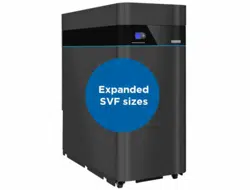Loading ...
Loading ...
Loading ...

Part number 550-100-252/0520
– 11 –
Fast-Track Setup — Requirements by Boiler
Fast-Track Setup
Unity
TM
control Fast-Track Setup takes advantage of the SVF
control WIZARD to provide the shortest possible method to set
up the control.
Perform the
Fast-Track Setup steps on page 12 to ensure the
minimum adjustments needed for ADVANCED mode control
operation are completed.
The remainder of this manual provides detailed information
about control setup and operation available for fine tuning,
troubleshooting and custom setup applications.
Temperature settings — You must ensure
that the
Unity
TM
control is set for the proper
water temperatures for the system. Exces-
sive water temperature can cause significant
property damage in some applications.
Multi-temperature systems — If the
heating system includes circuits that require
lower temperature water (radiant slab circuits,
for example) as well as higher temperature
circuits (DHW, finned tube baseboard, etc.),
it is recommended to protect low-temperature
circuits with limit controls that are wired to
one of the external limit circuits on the SVF
TM
boiler control. Failure to provide regulation
can result in substantial property damage.
Setup for single boilers
For single boilers not operated as part of an SVF
TM
network,
follow the single-boiler setup procedures in the SVF
TM
boiler
manual.
Using an external multiple boiler controller —
Remote modulation using an external controller
only works with each boiler set up as a SINGLE
boiler in the SVF
TM
Control setup. Follow instruc-
tions in this manual to setup the control using
ADVANCED mode.
Multiple boiler networks
Multiple boiler networks are configured with a MASTER boiler
and one or more SHADOW boilers. (See above for applications
using external controller.)
• The
MASTER boiler control regulates the firing of all boilers
when providing heat to the system zones.
•
SHADOW boilers respond to heat demand from the master
control except when operating for local (direct-connected)
heat calls.
Priorities
The SVF
TM
control allows assigning multiple priorities. These
priorities will be given preference in the order below:
• Multiple boilers: LOCAL PRIORITY 1, NETWORK PRIOR-
ITY 1, NETWORK PRIORITY 2, LOCAL PRIORITY 2.
• Single boilers: PRIORITY 1, PRIORITY 2, PRIORITY 3.
DHW circuit in system — For high-demand DHW
circuits, the control setting for MIN BOILERS must
be set using the NETWORK 1 or NETWORK 2
priority menu after the WIZARD is completed to
ensure quick response to demand. See page 62 for
a description of the MIN BOILERS setting.
Timings
Timing settings regulate boiler sequencing and ensure minimum
and maximum operating times for heating calls on each system.
Timings can be adjusted during the Wizard setup or manually,
as explained elsewhere in this manual.
Also see page 58 for additional information on control timings
and rotation and sequencing methods.
NET MIN ON TIME (multiple boilers only)
• This parameter is available during the Wizard or manually
in the NETWORK SETTINGS menu (Figure 36, page 57).
• When a boiler is being called on by the master boiler to satisfy
a
network demand, the boiler will fire for at least as long as
the MIN TIME ON NET before it switches to satisfy a Local
Priority if one is active.
• This timing avoids short cycling due to changes in demand.
MIN ON TIME
• This parameter is available during the Wizard or manually
in the PRIORITY SETTINGS menu (Figure 41, page 62).
• When the boiler is being called on to satisfy a higher priority,
the boiler will fire for at least as long as the MIN ON TIME
before it switches to satisfy that priority.
• This timing avoids short cycling due to changes in demand.
NET MAX ON TIME (multiple boilers only)
• This parameter is available during the Wizard or manually
in the NETWORK SETTINGS menu (Figure 36, page 57).
• When a boiler is being called on by the master boiler to satisfy
a
network demand, the boiler will fire for no longer than
the MAX TIME ON NET before it switches to satisfy a Local
Priority if one is active.
• This timing avoids a long-duration call from preventing other
demands from being met for too long a duration.
MAX ON TIME
• This parameter is available during the Wizard or manually
in the PRIORITY SETTINGS menu (Figure 41, page 62).
• When a boiler is being called on by to satisfy a lower priority,
the boiler will fire for no longer than the MAX ON TIME
before it switches to satisfy that priority.
• This timing avoids a long-duration call from preventing other
demands from being met for too long a duration.
SVF
™
Series 1
COMMERCIAL CONDENSING GAS-FIRED WAT ER BOILER
— Advanced Manual
Loading ...
Loading ...
Loading ...
